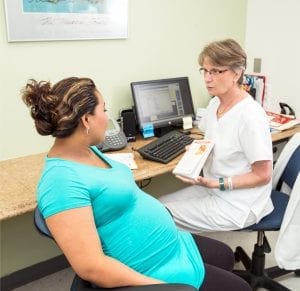This post is part of a series where we highlight the lives of the moms we serve. Specifically we want to bring a face to the complex issues we have begun addressing in this blog – such as care in the first trimester.
All stories are compilations from conversations with actual patients and additional research. To protect identities, we have used stock photos.
By Lindsey Hill, Intern
Medicaid benefits end 2 months after delivery – leaving new mothers without health insurance during a very risky postpartum period. Meet Sami, a young African American mother, who began experiencing extreme fatigue and swelling of her ankles towards the end of her pregnancy. These symptoms can be very normal toward the end and were quickly forgotten after the uneventful delivery of her baby.
Yet a few months later, Sami went to the hospital multiple times for extreme shortness of breath. The doctors she saw mistakenly attributed the cause as her history of asthma and sent her home. In addition, Sami missed a postpartum doctor visit due to lack of transportation. It wasn’t until a third hospital visit that she was diagnosed with heart failure (postpartum cardiomyopathy). Cardiomyopathy is a form of heart failure that can be fatal and is the leading cause of maternal deaths during the period from 1 week to 1 year after delivery. With her diagnosis, Sami needed frequent medical visits, had a weakened heart muscle, and a prolonged recovery.
This heart failure is difficult to detect because its symptoms can mimic those of a third trimester pregnancy, such as Sami’s fatigue and swollen ankles. Sami’s diagnosis could have been prevented if she had been educated about postpartum health risks, if her hospital providers had asked if she recently gave birth, or attending her postpartum visit. These would have likely resulted in an earlier cardiology consultation, and with more personalized care, the risk to Sami’s health would have been minimized.
Many pregnancy-related health complications, and even death, come from those who lose coverage or access to care after giving birth. This lack of access only magnifies the issues new mothers face – highlighting the importance of extending Medicaid coverage. Heart disease accounts for 1 in 4 maternal deaths and black women have a higher risk of heart-related maternal deaths. Developing nations like Southern Asia have achieved overall reduction in maternal mortality rates, yet the United States is the only developed country where the maternal mortality rate has been increasing since 1987.
2 out of every 5 U.S. births are through Medicaid and these poor outcomes many women and infants face could be addressed through expansion of Medicaid policy to extend the coverage period. State-led and federal initiatives can improve access to care and the quality of services pregnant women covered under Medicaid receive.
Even though she was left without health insurance after her Medicaid benefits ended, Sami was fortunate to catch her postpartum heart failure when she did. Sami and her baby are doing well today.


